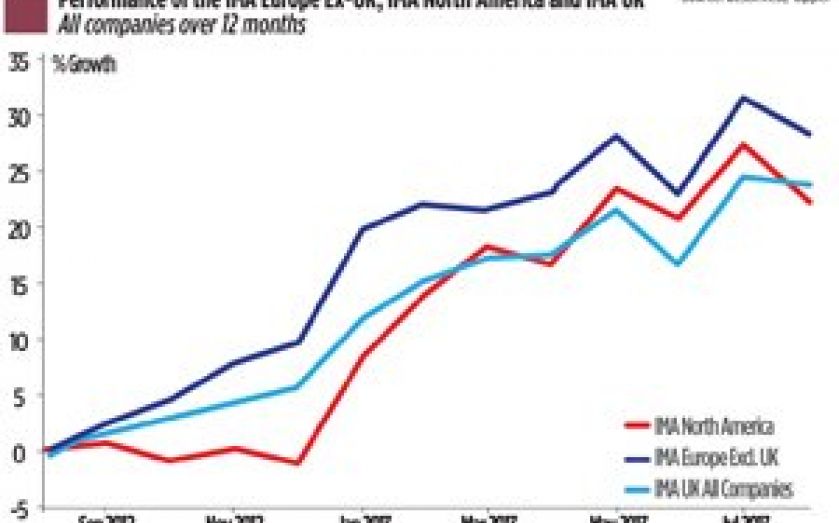Euro stocks may be turning a corner

But investors should not ignore the risks surrounding relatively cheap equities in European markets
SEPTEMBER has historically been a volatile month for markets. According to BestInvest analysis of FTSE All Share Index monthly returns since 1986, it is the worst performer for equities, with four major crashes: 1992’s Black Wednesday, the 9/11 terrorist attacks, the second leg of the Dot com crash in 2002, and the collapses of Lehman brothers and AIG in 2008.
The reasons behind this are unknown (some cite seasonal factors, like the return from summer holidays and the nights drawing in), but what is clear is that, this September, investors are particularly spooked. “We’ve had emerging markets in a mini-meltdown over the summer. This, combined with the unresolved situation in Syria, could be causing disquiet,” says Tom Stevenson of Fidelity.
In addition, US Federal Reserve chairman Ben Bernanke could announce the tapering of monetary stimulus in a Fed meeting next week. And following the German elections later this month, difficult decisions regarding the peripheral Eurozone countries will be unavoidable.
TURNING A CORNER
Indeed, the Eurozone has been plagued by macroeconomic and political uncertainty over the past few years. As a result, European equities currently form a negligible portion of most diversified portfolios. Clients investing through Hargreaves Lansdown Vantage, for example, only hold an average of 5.13 per cent in European funds. But European bourses have performed strongly this year, boosted by news that the Eurozone returned to growth in the second quarter of 2013 for the first time since 2011.
What’s more, US investors are flocking to buy European shares at the fastest rate since 1977. Indeed, pension funds and other large US organisations invested $65bn (£41.3bn) in European equities in the first half of this year. Stevenson attributes this renewed confidence in the region to a number of factors.
First, European equities are cheaper than other developed markets, like the US and Japan. “And yet, European markets have risen by around 25 per cent since European Central Bank president Mario Draghi promised to do ‘whatever it takes’ to save the euro in July last year,” he says. He quotes research from HSBC, which found European stocks are still 15 per cent undervalued compared with the long-term average. And according to Goldman Sachs, US stocks are currently valued at 13.5 times next year’s expected earnings, compared to 12 times for European shares.
Secondly, there are a number of strong global brands in Europe, which are financially robust and in a position to benefit from growth anywhere in the world. Europe is home to over 130 Fortune 500 companies, many of which have global reach and can benefit from international growth despite the continued implications of structural issues in the Eurozone.
And finally, European equities are increasingly being viewed as a safe haven when compared to emerging market stocks. In the past 12 months, the MSCI Europe index has risen 15 per cent, compared with just 0.5 per cent for the MSCI Emerging Markets index. Since the weeks preceding Draghi’s comments last July, the MSCI Europe has risen by 35 per cent.
MITIGATING RISK
But Jason Hollands of BestInvest advises caution. “There is a widely held assumption that greater Eurozone reforms will be implemented after the German elections in September. But a majority for the centre-right is not guaranteed, and an upset for Merkel’s coalition would again re-focus investor attention on the longer run problems within the Eurozone,” he says.
And equity markets still face significant risks, not least continued worries over tensions in the Middle East. As such, Hollands thinks more cautious investors should favour funds focused on global businesses domiciled in Europe, rather than those with strong domestic focus. Adrian Lowcock of Hargreaves Lansdown, meanwhile, suggests mitigating risk by making small, regular payments rather than lump sums.
Hollands’s top core choices include Henderson European Focus and Threadneedle European Select, which provides exposure to quality companies in the region. He also likes Baring European Select – a fund focused on small and mid-cap stocks. And while smaller companies have been a success story of the summer, BlackRock’s Continental European Fund, which has returned 31.89 per cent since August 2012, also has a bias towards higher quality companies.
INVESTMENT OPTIONS
More sophisticated investors may opt to pick select stocks, and BlackRock’s Andreas Zoellinger thinks the industrials sector offers good opportunity for international growth. He points to Kone – a Finnish domiciled global lift company – which has strong exposure to the US, no debt, and has grown earnings at a compounded rate of more than 10 per cent in the past five years.
But to get maximum diversification for the lowest price, Jason Witcombe of Evolve Financial Planners says investors should buy tracker funds. He highlights the Vanguard FTSE Developed Europe Ex-UK Equity Fund, which has a 0.25 per cent annual management fee, and is currently yielding at 1.66 per cent. “It has access to 380 shares, giving a broad diversification across a number of countries,” he says. The downside to a tracker or passive vehicle is that, while cheap, even if you match the market, the small fee incurred means you could underperform relatively.
Witcombe also thinks that investors should avoid attempting to time the market, or react to news that a particular sector is offering good returns. Instead, he says investors should agree how much of their portfolio they want in US, European, UK and emerging markets, and stick to that goal. Lowcock suggests the average investor should aim to have around 10 per cent invested in each market to mitigate the risks currently associated with investing in Europe – or 5 per cent in emerging markets for those with a lower risk tolerance.
The Eurozone crisis, of course, has not really gone away. So while European stocks are comparatively cheap, the positives may not outweigh the risks.